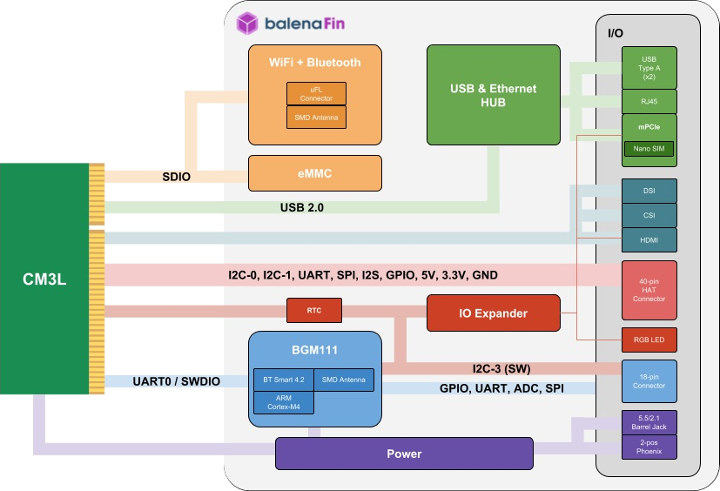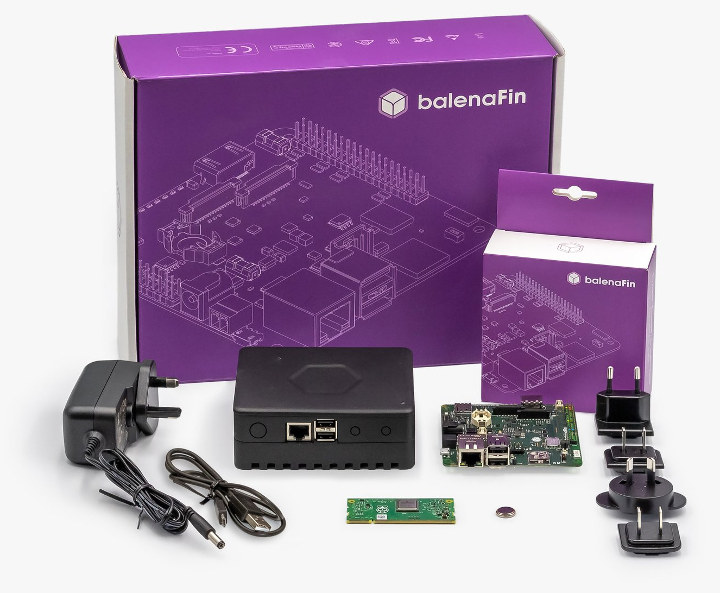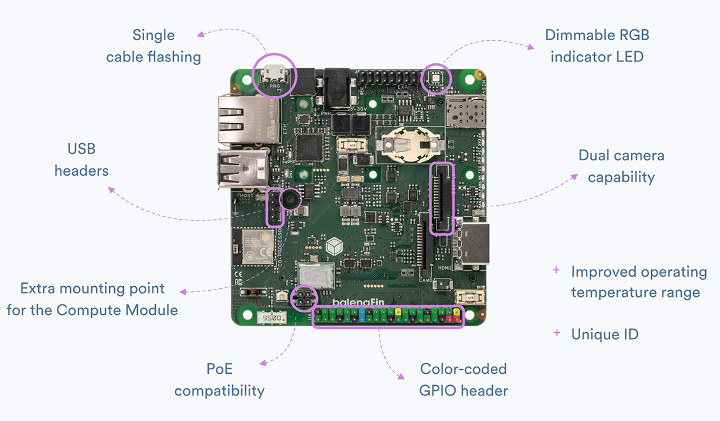Balena.io – previously known as resin.io – first unveiled Resin.io Project Fin in March 2018. The carrier board for Raspberry Pi CM3L was designed with the aim of easing the management of fleets of connected devices thanks to ResinOS operating systems and the ability to deploy apps packaged in containers through their balenaCloud service.
The project had been renamed to balenaFin a little while ago, and the company has now announced availability of balenaFin 1.1 developer kit with various improvements including support for PoE, dual camera, and Raspberry Pi CM3+/Lite module.
balenaFin v1.1 carrier board specifications with improvements highlighted in bold:
- Supported SoM
- Raspberry Pi Compute Module 3 Lite with Broadcom BCM2837 quad-core ARM Cortex A53 processor at 1.2GHz, 1GB RAM
- Raspberry Pi Compute Module 3+/Lite with Broadcom BCM2837B0 quad-core ARM Cortex A53 processor at 1.2GHz, 1GB RAM
- Storage – 8, 16, 32, or 64 GB industrial grade eMMC 5.1 flash
- Connectivity – 10/100M Ethernet, Dual-band 802.11ac/a/b/g/n 2.4 & 5GHz WiFi + Bluetooth 4.2
- Expansion
- Color-coded Raspberry Pi 40-pin HAT
- 1x Mini PCI Express subset socket (USB, UART and I2C) with nano-SIM card socket
- Video Output / Display – HDMI output, RPi display connector (multiplexed with one RPi camera)
- Camera – 2x RPi camera connectors
- USB – 2x USB 2.0 Type-A ports, 1x micro USB port for flashing, 1x 4-pin USB 2.0 header
- Co-processor
- IoT Module – Samsung Artik 020 IoT module with Silicon Labs BGM111 Arm Cortex M4 MCU @ 40 MHz, 32kB RAM, 256 kB flash, Bluetooth 4.2 Smart connectivity
- I/O – 1x I2C, 1x SPI, 1x debug UART, 8x GPIO / ADC
- Misc – RTC via I2C chip with CR122 coin-cell battery, 1x dimmable RGB LED, 9 x Status LEDs, power in fuse (3A 125VAC/VDC), HAT 5V fuse (3A 125VAC/VDC) PoE headers
- Power Supply
- 6 to 24V via barrel jack or 2-position phoenix connector
- 5V @ 2.5A via HAT connector
- PoE (Power-over-Ethernet) via add-on board
- Dimensions – 90 x 90 mm (PCB)
- Temperature Range – -20 to 70°C

Other improvement include the ability to flash via micro USB port without having to connect a power supply, an extra mounting point for the Compute Module in order to improve vibration resistance, and each board has now an uniquely identifiable data matrix printed on the board (Unique ID).
The board comes without OS, but you can easily flash one of the balenaOS 2.x variants (production, development, standalone) o the board using Etcher tools while the board is connected to your computer via the micro USB port as explained in the getting started guide. Standalone balenaOS is just a Linux distribution with docker, but without access to balena’s app / device management service.

The board is sold as part of balenaFin 1.1 developer kit for $179 with a balenaFin carrier board with 8GB flash a Raspberry Pi Compute Module 3+ Lite (CM3+/L), a 12V/1.5A international PSU, and a micro USB to USB cable. You may want to spend $20 extra to get the modular DIN-rail case as part of the kit as pictured above.

Jean-Luc started CNX Software in 2010 as a part-time endeavor, before quitting his job as a software engineering manager, and starting to write daily news, and reviews full time later in 2011.
Support CNX Software! Donate via cryptocurrencies, become a Patron on Patreon, or purchase goods on Amazon or Aliexpress





